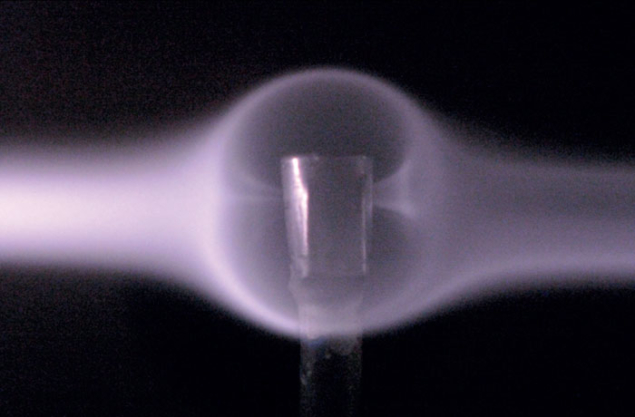
Image credit: NASA.
The origin of the enigmatic “lunar swirls” – patches of relatively pale lunar soil, some measuring several tens of kilometres across – has been an unresolved mystery since the mid-1960s, when NASA’s Lunar Orbiter spacecraft mapped the surface of the Moon in preparation for the Apollo landings. Now, a team of physicists has used a combination of satellite data, plasma-physics theory and laboratory experiments to show how the features can arise when the hot plasma of the solar wind is deflected around “mini-magnetospheres” associated with magnetic anomalies at the surface of the Moon.
Initially thought to be smeared-out craters, close-range photographs from Lunar Orbiter II showed that at least one large swirl – named Reiner Gamma, after the nearby Reiner impact crater – could not be a crater. Studies from subsequent Apollo missions revealed that the swirls are associated with localized magnetic fields in the lunar crust. Because the Moon today has no overall magnetic field, these “magnetic anomalies” seem to be remnants of a field that has existed in the past.
In 1998–1999, the Lunar Prospector mission discovered that the magnetic anomalies create miniature magnetospheres above the Moon’s surface, just as the Earth’s planetary magnetic field does on a much larger scale when it deflects the charged particles of the solar wind around the planet. Could the mini-magnetospheres on the Moon, which are only a few hundred kilometres in size, somehow shield the crust from the solar wind and so prevent the surface from darkening as a result of constant bombardment by incoming particles?

Image credit: Ruth Bamford.
One problem with this idea has been that the magnetic fields – in the order of nanotesla – seem to be too weak to affect the energetic particles of the solar wind on the scales observed. However, a team led by Ruth Bamford of the Rutherford Appleton Laboratory and York University has shown that it is the electric field associated with the shock formed when the solar wind interacts with the magnetic field that deflects the particles bombarding the Moon.
Data from various lunar-orbiting spacecraft suggested a picture in which the solar wind is deflected round a magnetic “bubble”, creating the effect of a cavity within the plasma density that is enclosed by a “skin” that is only kilometres thick. This skin effectively reflects incoming protons, increasing their energy.
To explain these observations, Bamford and colleagues invoke a two-fluid model of the plasma, with unmagnetized ions and magnetized electrons. The electrons are slowed down and deflected by the magnetic barrier that forms when the magnetic field of the solar wind encounters the magnetic anomaly – but the much heavier ions do not respond so quickly. This leads to a separation in space-charge and hence an electric field.
The team confirmed the principle of their theoretical model by using a plasma wind tunnel with a supersonic stream of hydrogen plasma and the dipole field of a magnet. The experiment showed that the plasma particles were indeed “corralled” by a narrow electrostatic field to form a cavity in the plasma, so protecting areas of the surface towards which the particles were flowing. Translated to the more irregular magnetic fields on the lunar surface, with a range of overlapping cavities, this can provide the long-awaited explanation of the light and dark patterns – protected and unprotected regions, respectively – that make up the swirls.
Further reading
Bamford et al. 2012 Phys. Rev. Lett. 109 081101.








